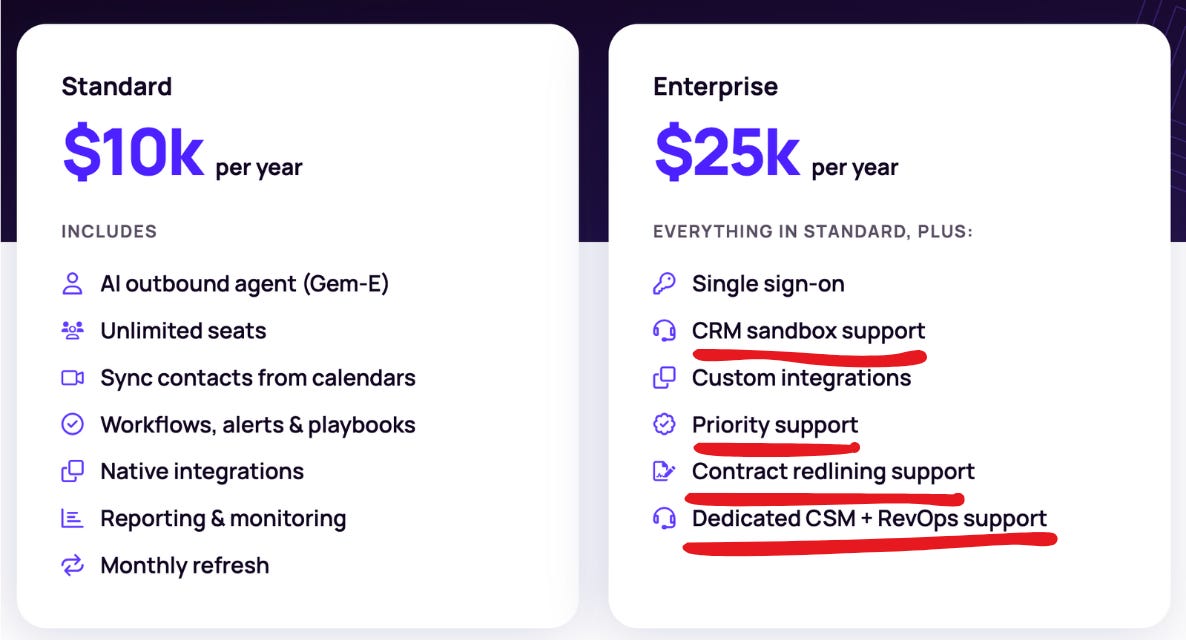Why Human Support Is Becoming a Premium Feature in AI-Powered SaaS
Plus: Updates from Fivetran, Harness, and AssemblyAI.
Welcome back to Good Better Best!
First thing — we dropped a new benchmarks report this week that’s jam-packed with data and examples. Check it out here.
Otherwise, a couple cool events in our network coming up next week:
On Monday, our partner Ulrik Lehrskov-Schmidt is hosting a webinar breaking down the 4 trends he saw in SaaS pricing in 2024. The first half of the webinar will focus on that, the second half will be a live Q&A. Sign up here.
On Tuesday, I’ll be joining a panel hosted by
and the kind folks at Maven to talk about the future of Growth in SaaS, and why generalists are winning. Sign up here.
This week, we’re breaking down how SaaS companies are positioning human support in the age of AI, and why it’s an underrated lever to pull.
First, some of the most interesting updates we saw on PricingSaaS this week.
📰 Pricing News & Updates
Alchemy adjusted support response time.
Apollo GraphQL introduced a GBB model.
Harness renamed its plans.
Fivetran consolidated plans.
AssemblyAI updated customer support offerings.
Today’s Post is brought to you by Metronome
Metronome is the usage-based billing platform powering how the fastest-growing companies, like OpenAI, Anthropic, and Databricks, quickly launch new products and pricing.
On 2/26 at 10am PT, Metronome will be hosting a deep dive into the future of SaaS pricing with Kyle Poyar, author of the Growth Unhinged newsletter and pricing expert. They’ll cover:
Best practices and operational challenges of adopting usage-based pricing and aligning pricing with customer value
Trends like AI-driven pricing and outcome-based models
Kyle’s 2025 pricing predictions and how to use them to stay competitive
Tune in next Wednesday at 10am PT. Register today.
Humans as a Premium Feature
Last week, I spotted an interesting pricing change.
Botpress, an open-source platform that allows users to create AI agents, added a new feature to its team plan: Dedicated Support for delivering white-labeled agents to your clients. In other words, our humans will help you replace your humans.
The move illustrates a packaging strategy that’s been on my mind while thinking about AI Agents and humans. The strategy is called the value ladder, and essentially, you package your tiers by level of service:
→ Tier 1: "Do it yourself"
→ Tier 2: "Do it with our help"
→ Tier 3: "We do it for you"
The sequence makes sense because with each upgrade, the customer gets more value. But historically, its been way more relevant for services than software. It’s rare that a SaaS company could actually “do” a job for you. Until now.
GenAI and outcome-based pricing are making that possible, and we’re starting to see the early signs of how it might look. Instead of monetizing based on access to features and usage limits, SaaS companies can monetize by:
Sophistication of the job (Do it cheaply → Do it well → Do it perfectly)
Scope of jobs (Do it yourself → We do X for you → We do X and Y for you)
The big shift here is that AI will drastically commoditize self service, and move monetization further down the value spectrum.
Beyond Botpress, other early examples include:
UserGems, which offers an Outbound AI Agent in the Standard Plan, but monetizes human support in the Enterprise plan:
Salesforce, which made waves with Agentforce, also introduced Agentforce Activator, a Professional Services package to help users map an AI agent strategy, including:
Defining your ideal agent
Agent configuration
Testing and feedback
Until AI Agent Engineers become a default hire, companies will need help from humans to fully leverage agentic products. In that context, we might be entering a golden age of professional services, where humans are a premium feature.
🎯 Expert Insight
Professional Services are an excellent way to help customers derive value from a SaaS products. Services are peripheral to a SaaS company's core functionality, and can help customers multiply the value of the functional features in the product.
There are many ways a B2B SaaS company can leverage professional services. Here’s a non-exhaustive list:
Onboarding services to help customers get started.
Migration services to help customers move data to a new product.
Ongoing Support services to help customers get value out of the day-to-day use of the product.
Training services to help customers learn to use the product.
Professional services to help customers with a specific product function.
Technical services to help customize the product for a customers’ needs (e.g., development and configuration).
Managed services to help customers outsource work in your product.
Monetizing services can also communicate value, and help drive adoption. Services are particularly useful with large customers, since they usually have bargaining power to drive down the price of the core software.
An argument can be made for not monetizing services and simply giving them away. While that can be the right approach sometimes, it probably isn’t as a company grows. Most B2B SaaS companies eventually include services in their revenue mix.
If you’re looking to learn more about pricing professional services, I recorded a webinar breaking down the strategy.
How we can help when you’re ready
Got questions? Join the free PricingSaaS Community to get fast answers from pricing leaders.
Leveling up? Check out our Resource Center for links to pricing and packaging research, webinars, and our free online course.
Need help? Our SaaS Pricing Assessment delivers a clear roadmap to smarter pricing and packaging in 30 days.





